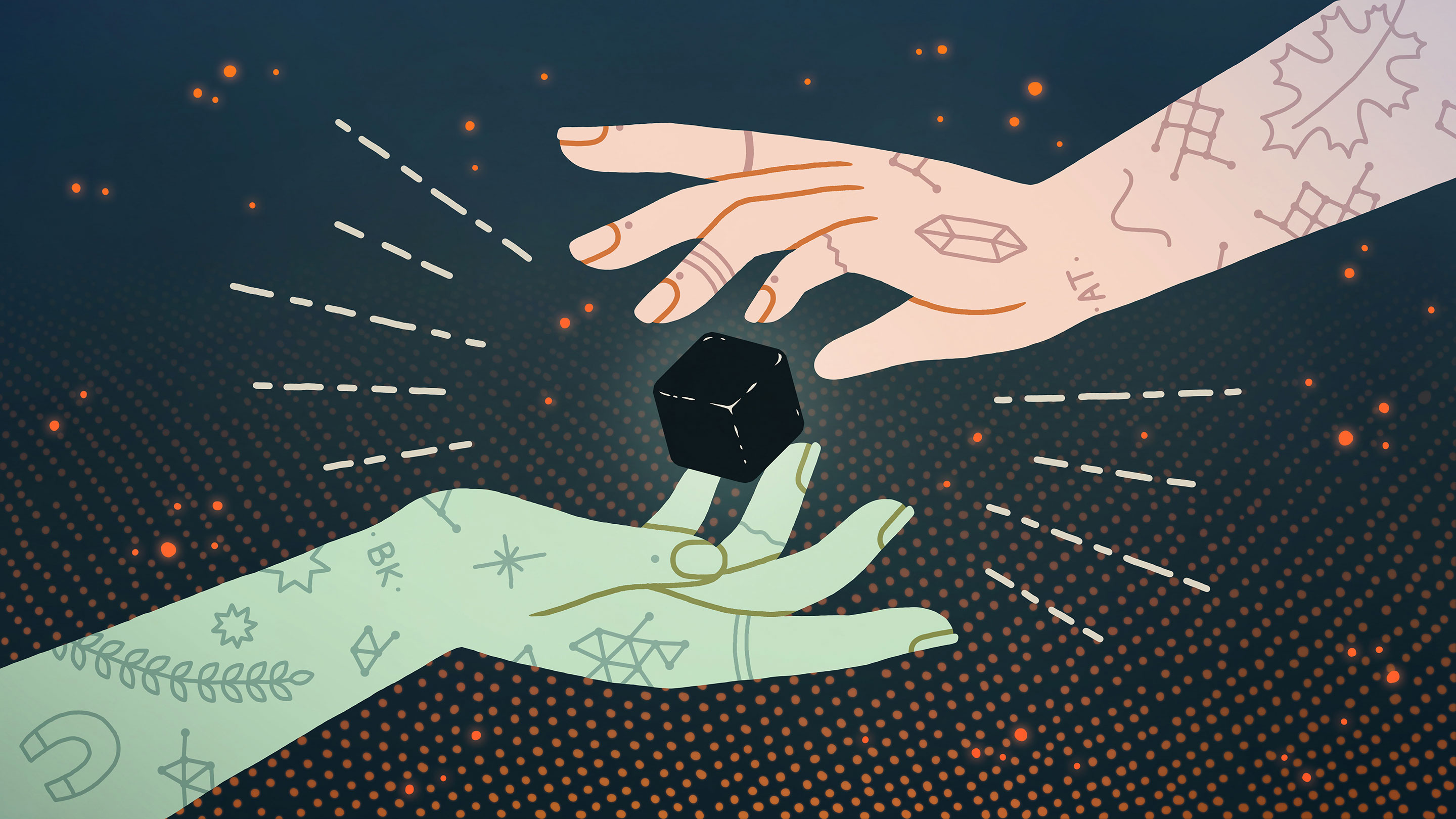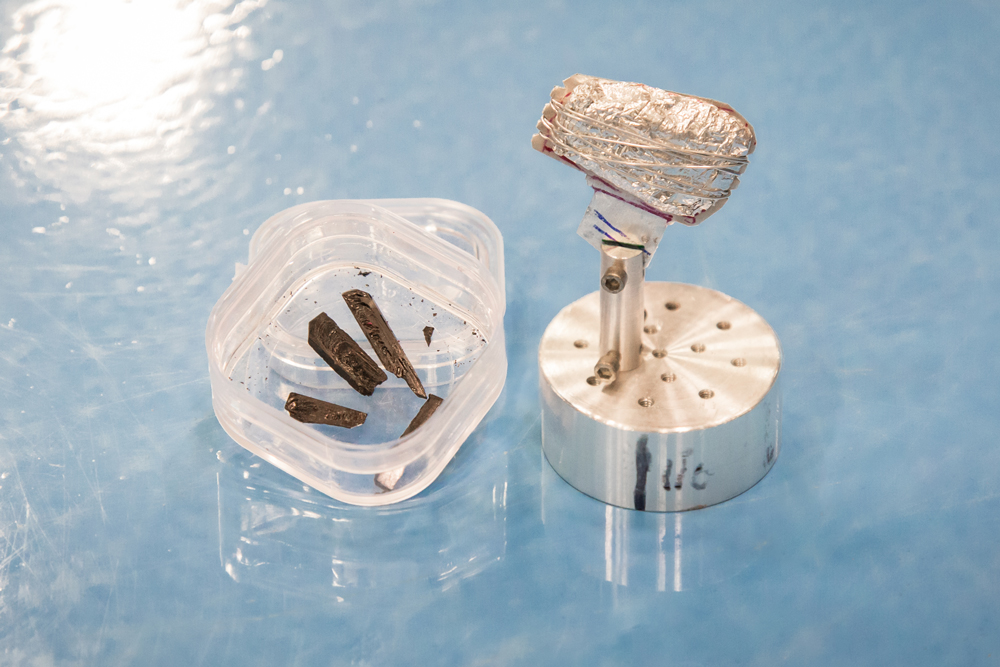Elusive Higgs-Like State Created in Exotic Materials

Camille Chew for Quanta Magazine
Introduction
If you want to understand the personality of a material, study its electrons. Table salt forms cubic crystals because its atoms share electrons in that configuration; silver shines because its electrons absorb visible light and reradiate it back. Electron behavior causes nearly all material properties: hardness, conductivity, melting temperature.
Of late, physicists are intrigued by the way huge numbers of electrons can display collective quantum-mechanical behavior. In some materials, a trillion trillion electrons within a crystal can act as a unit, like fire ants clumping into a single mass to survive a flood. Physicists want to understand this collective behavior because of the potential link to exotic properties such as superconductivity, in which electricity can flow without any resistance.
Last year, two independent research groups designed crystals, known as two-dimensional antiferromagnets, whose electrons can collectively imitate the Higgs boson. By precisely studying this behavior, the researchers think they can better understand the physical laws that govern materials — and potentially discover new states of matter. It was the first time that researchers have been able to induce such “Higgs modes” in these materials. “You’re creating a little mini universe,” said David Alan Tennant, a physicist at Oak Ridge National Laboratory who led one of the groups along with Tao Hong, his colleague there.
Both groups induced electrons into Higgs-like activity by pelting their material with neutrons. During these tiny collisions, the electrons’ magnetic fields begin to fluctuate in a patterned way that mathematically resembles the Higgs boson.

A crystal made of copper bromide was used to construct the Oak Ridge team’s two-dimensional antiferromagnet.
Genevieve Martin/Oak Ridge National Laboratory, U.S. Dept. of Energy.
The Higgs mode is not simply a mathematical curiosity. When a crystal’s structure permits its electrons to behave this way, the material most likely has other interesting properties, said Bernhard Keimer, a physicist at the Max Planck Institute for Solid State Research who coleads the other group.
That’s because when you get the Higgs mode to appear, the material should be on the brink of a so-called quantum phase transition. Its properties are about to change drastically, like a snowball on a sunny spring day. The Higgs can help you understand the character of the quantum phase transition, says Subir Sachdev, a physicist at Harvard University. These quantum effects often portend bizarre new material properties.
For example, physicists think that quantum phase transitions play a role in certain materials, known as topological insulators, that conduct electricity only on their surface and not in their interior. Researchers have also observed quantum phase transitions in high-temperature superconductors, although the significance of the phase transitions is still unclear. Whereas conventional superconductors need to be cooled to near absolute zero to observe such effects, high-temperature superconductors work at the relatively balmy conditions of liquid nitrogen, which is dozens of degrees higher.
Over the past few years, physicists have created the Higgs mode in other superconductors, but they can’t always understand exactly what’s going on. The typical materials used to study the Higgs mode have a complicated crystal structure that increases the difficulty of understanding the physics at work.
So both Keimer’s and Tennant’s groups set out to induce the Higgs mode in simpler systems. Their antiferromagnets were so-called two-dimensional materials: While each crystal exists as a 3-D chunk, those chunks are built out of stacked two-dimensional layers of atoms that act more or less independently. Somewhat paradoxically, it’s a harder experimental challenge to induce the Higgs mode in these two-dimensional materials. Physicists were unsure if it could be done.
Yet the successful experiments showed that it was possible to use existing theoretical tools to explain the evolution of the Higgs mode. Keimer’s group found that the Higgs mode parallels the behavior of the Higgs boson. Inside a particle accelerator like the Large Hadron Collider, a Higgs boson will quickly decay into other particles, such as photons. In Keimer’s antiferromagnet, the Higgs mode morphs into different collective-electron motion that resembles particles called Goldstone bosons. The group experimentally confirmed that the Higgs mode evolves according to their theoretical predictions.
Tennant’s group discovered how to make their material produce a Higgs mode that doesn’t die out. That knowledge could help them determine how to turn on other quantum properties, like superconductivity, in other materials. “What we want to understand is how to keep quantum behavior in systems,” said Tennant.
Both groups hope to go beyond the Higgs mode. Keimer aims to actually observe a quantum phase transition in his antiferromagnet, which may be accompanied by additional weird phenomena. “That happens quite a lot,” he said. “You want to study a particular quantum phase transition, and then something else pops up.”
They also just want to explore. They expect that more weird properties of matter are associated with the Higgs mode — potentially ones not yet envisioned. “Our brains don’t have a natural intuition for quantum systems,” said Tennant. “Exploring nature is full of surprises because it’s full of things we never imagined.”
This article was reprinted on Wired.com.



